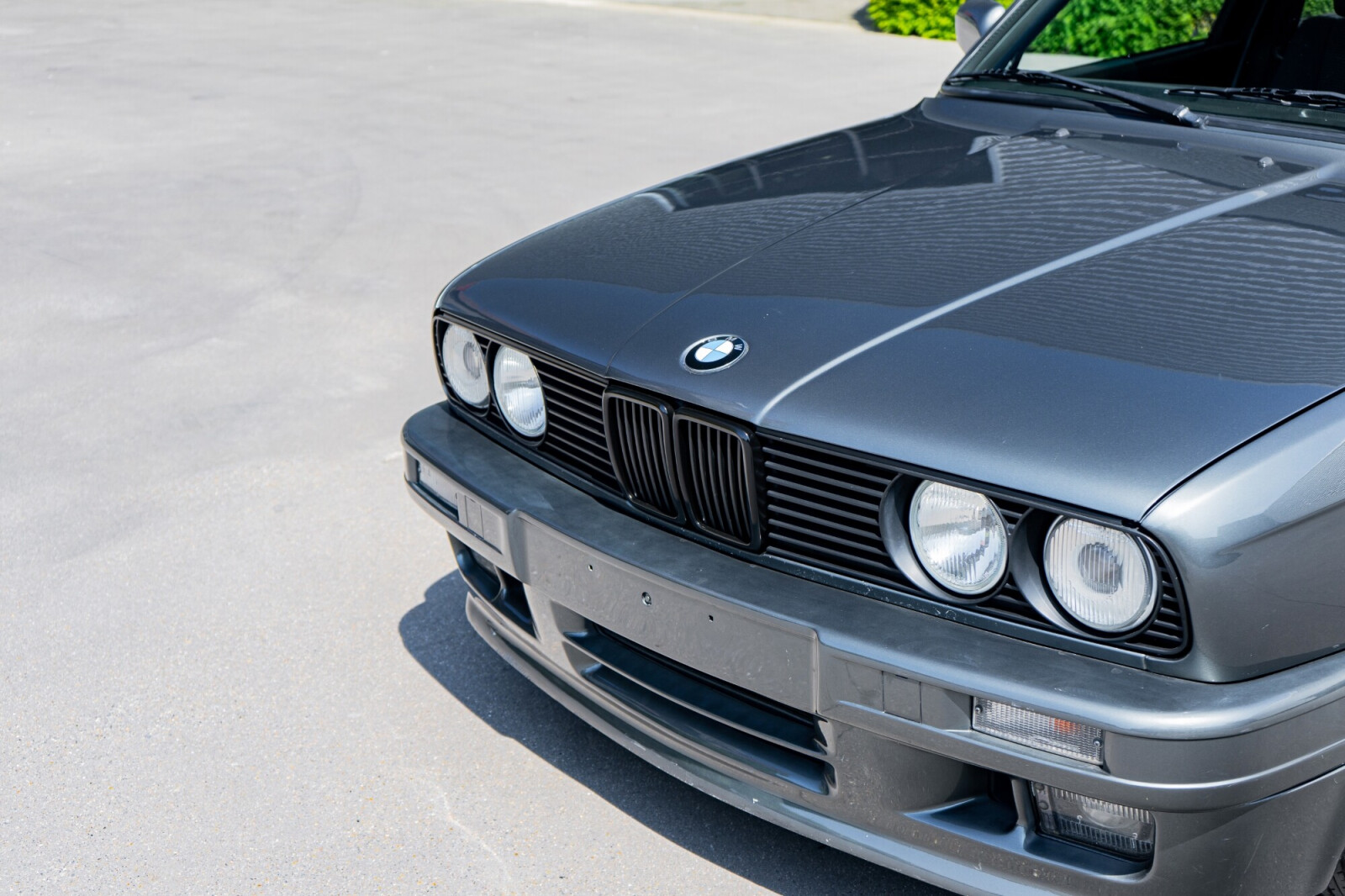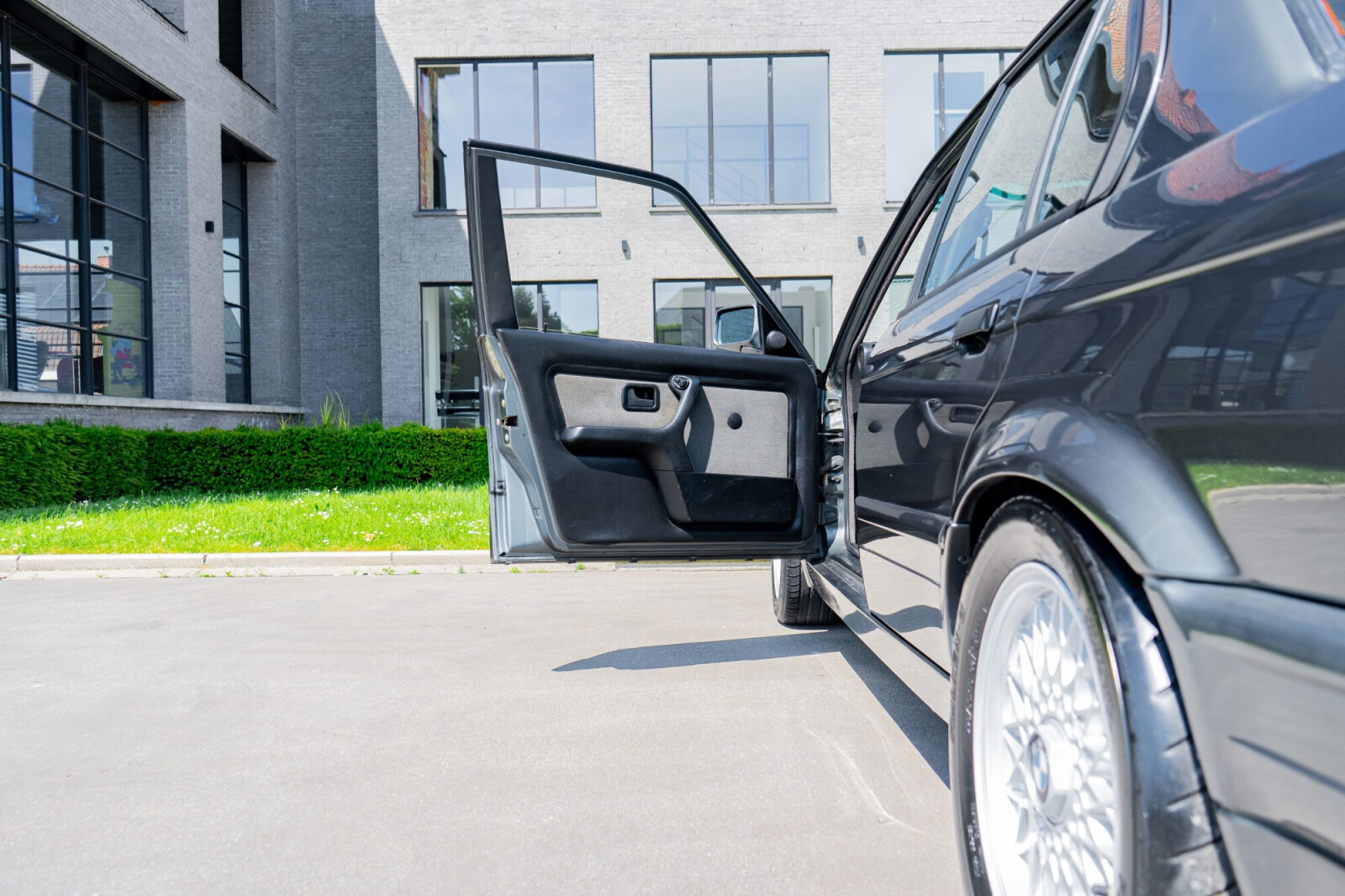BMW 320iS
- Chassis: WBAAC95030061510*1
- Engine: 2.0l inline 4
- Transmission: Manual gearbox
- Mileage: 106000 km
- Color: Delphin Grau Metallic (184) / Anthracite Cloth (0269)
- The 'Italian' M3
- A rare example of a true 90's Q car
- Recent mechanical overhaul
- Great agile & fast four door saloon
- 1 of just 1.205
THE 'ITALIAN' M3
The BMW 320is is one of the least well-known variants of the BMW E30 – one of the most popular model lines in the German marque’s 104 year history. People who are familiar with the E30 with probably also be familiar with the 318is and the 325is variants, essentially the sporting versions of the model that sit under the ultimate version of the E30 – the BMW E30 M3.
With both the Italian and Portuguese governments imposing harsh taxation policies on cars with an engine capacity of over 2 litres, it was hardly surprising that European manufacturers would develop performance models for their clients in these markets to overcome the rules. Following the example set by Ferrari with the 208s, BMW’s E30 M3 just fell afoul of the tax rules with its 2.3 – 2.5 litre engine so the 320is was born. Using a de-stroked version of the M3’s S14 engine, the 320is’ capacity came in at 1,990 cc with power only slightly down at 192 bhp, aided by a higher compression ratio than the M3. In addition to the engine, the M3’s Getrag 265 5-speed gearbox was used along with a limited-slip differential with a shorter ratio than its more famous cousin.
In true ‘Q car’ fashion, the flared wheel arches of the M3 were left off, with an M-Technic II aero package being the only sign to passers-by that this was not an ordinary 320. Further features included ‘Sportfahrwerk’ suspension and various subtle details such as an M3 instrument cluster without the red needles or M-division logo. Despite BMW’s intentions, only 2540 two-door examples left the factory at Regensberg making the 320is one of the rarest BMWs of the era.
THIS 320iS
Offered from a client's collection, this 320is is an original ‘AC95’ Italian-delivery 4-door example. Delivered in Delphin Grau Metallic, this 320is presents very well today with around 106,000km on the odometer. An extremely clean example throughout the exterior, interior and engine bay, this 320is is accompanied with its correct tools.
The car recently received a mechanical overhaul including dampers, discs, brakes, fluids,...
The 320iS is a remarkably rare version of the hallowed E30-generation 3-Series that was produced solely for the Italian and Portuguese markets, and has often been nicknamed the ‘Italian M3’. Designed with a shorter stroke version of the S14 engine mated to the M3’s Getrag gearbox, this handsome sporting saloon was described as an “ultra-collectible M3-lite” by Road and Track. Offered for sale in excellent mechanical condition, this E30 would make a natural addition to any collection of BMWs as well as an involving weekend plaything.
- Mark
- BMW
- Model
- 320iS
- VIN number
- WBAAC95030061510*1
- First use
- 01/1988
- Mileage
- 106000 km
- Power
- 192 hp
- Fuel
- Gas/Petrol (normal)
- Transmission
- Manual gearbox
- Color
- Delphin Grau Metallic (184)
- Interior
- Anthracite Cloth (0269)
History
What makes the E30 320is unique?
The E30 320is is a special 3 Series model that was sold exclusively in Italy and Portugal in order to take advantage of the reduced taxes in those countries for cars with engines that displace two liters or less. It is powered by a 1990cc version of the four-cylinder S14 engine developed by BMW Motorsport for the E30 M3 and also shares its close-ratio Getrag gearbox with the M3. However, all other components are standard 3 Series items.
Where was the E30 320is built?
The E30 320is was built on the normal Regensberg assembly line alongside the other 3 Series models.
If the E30 320is is powered by an M engine, why is not badged as an M model?
The reason the E30 320is is not badged as an M model ultimately comes down to marketing: Unlike the limited-production M3, which was created primarily as a competition machine and utilizes many unique exterior body panels and chassis components, the 320is was never intended to be a homologation special. It was conceived instead as a sportier and more affordable alternative to the torquier and more refined 325i, which was taxed heavily in Italy and Portugal due to its 2.5-liter engine.
Production Data
How many versions of the E30 320is were developed?
BMW developed the E30 320is only in non-catalyst, left-hand drive form and exported it exclusively to Italy and Portugal. Both two-door and four-door body styles were offered.
How many of each version were produced?
AK95 ((ECE-spec two-door, LHD): 2,540* produced from 03/1988 through 11/1990
AC95 (ECE-spec four-door, LHD): 1,205 produced from 09/1987 through 07/1990
*includes one pre-production example produced 11/1987
What changed during the production of the E30 320is?
There were no mechanical changes to the E30 320is during the three years that it was produced. However, there were a number of minor cosmetic and equipment variations that also apply to every E30 3 Series model built during the same period.
Drivetrain
What makes the two-liter S14 engine unique?
The two-liter S14 engine in the E30 320is is essentially identical to the 2,302cc version found in the E30 M3 except for its shorter stroke (72.6mm versus 84mm) that yields an overall displacement of 1,990cc. Like all S14 engines, it combines the basic four-cylinder block from the M10 family with a four-valve head derived from the one used on the six-cylinder M88 and S38 motors. Special features of this engine include individual throttle plates for each cylinder, machined intake and exhaust ports, and a crankshaft with eight counterweights. Like the M88 and S38, the S14 does not have hydraulic lifters, and thus requires periodic valve adjustments.
The two-liter S14 is rated at 192 hp (DIN) at 6,900 rpm and 155 lb/ft of torque at 4,900 rpm. This is down slightly compared to the non-catalyst, 2.3-liter S14 used in the E30 M3 which is rated at 200 hp (DIN) at 6,750 and 176 lb/ft of torque at 4,750 rpm.
The S14 engine fitted to the 320is has an identical appearance to the unit found in the E30 M3 and thus shares the "BMW M Power" inscription on its cam cover.
What kind of gearbox does the E30 320is have?
Like the European-spec E30 M3, the sole gearbox for the E30 320is is a close-ratio Getrag 260 five-speed manual with a "dogleg" shift pattern and the following ratios: 3.72 (1), 2.40 (2), 1.77 (3), 1.26 (4), 1.00 (5). This is mated to a shorter (compared to the M3) 3.46:1 rear axle ratio with limited-slip differential.
Chassis
How is the suspension of the E30 320is different from that of a standard E30 3 Series?
Like all E30 3 Series, the suspension of the 320is consists of a MacPherson strut/semi-trailing arm design.However, the springs, shocks and anti-roll bars of all two-doors (as well as four-doors produced from 9/89) are of the more aggressive "Sportfahrwerk" specification.
What kind of steering does the E30 320is have?
The 320is uses the standard E30 power-assisted rack-and-pinion steering system with an overall ratio of 20.5:1.
What size brakes does the E30 320is have?
The E30 320is shares its braking system with the six-cylinder E30 models and thus is equipped with 10.2-inch (260mm) vented disc brakes in the front and 10.2-inch (260mm) solid disc brakes in the rear. ABS was fitted as standard equipment.
What are the factory wheel and tire sizes for the E30 320is?
The E30 320is is equipped exclusively with 195/65VR14 tires. These are mounted to one of two different alloy wheel designs, both of which were shared with other E30 3 Series models: The 6.5x14-inch cross-spoke wheel (standard on the two-door) or the more plain 6x14-inch alloy (standard on the four-door).
Cosmetics
How is the exterior of the E30 320is different from that of a regular 3 Series?
The exterior of the 320is can only be identified from other E30 3 Series models by its "320is" badging on the trunk lid, though this could be deleted upon request. (The curved dual exhaust tips are also unlike those of any other four-cylinder 3 Series but are shared with the six-cylinder E30 325i.
The exterior of the four-door E30 320is is otherwise the same as any basic E30 sedan, equipped as standard with only fog lights and 14-inch alloy wheels. However, front and rear spoilers, Shadowline (dechromed) exterior trim, plus the sportier 14-inch cross-spoke alloy wheels, were offered as extra-cost options.
The two-door version of the E30 320is is further equipped with the complete M-Technic II aero package (identical to the one fitted to the UK-spec 325i Sport and available as an accessory on all other E30 3 Series models), which consists of a deeper front airdam, additional lower side body panels, an extended valance under the rear bumper and a two-piece rear spoiler. In addition, the two-door E30 320is sports body-color rearview mirror housings, Shadowline (dechromed) window trim and 14-inch cross-spoke alloy wheels.
How is the interior of the E30 320is different from that of a regular 3 Series?
The interior of the E30 320is is identical to that of other 3 Series models with the sole excpetion of its unique instrument cluster that utilizes the same tachometer with integrated oil temperature gauge as the E30 M3, but lacks the red needles and M logo between the two main dials. Also, the gear shift knob is of the older non-ergonomic design that was phased out on other E30 3 Series models (with the exception of the M3) in September, 1987.
The interior of the four-door E30 320is is quite Spartan, offering only the basics such as power mirrors, central locking, power front windows and a rear-window defroster as standard equipment. The two-door model adds map lights in the rear view mirror, sport seats, a three-spoke leather-wrapped M-Technic steering wheel and a leather shift knob, all of which were also available on the four-door as extra-cost options.
Factory options for both two-door and four-door versions of the 320is included: air conditioning, manual sunroof, power sunroof, interior headlight adjustment, BMW Sound System, heated front seats, digital clock with outside temperature display, on-board computer, rear headrests, rear sunshade and leather upholstery.
bmwmregistry.com

































